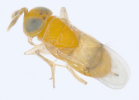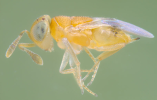 |
Scientific nameAcerophagus papayae Noyes & Schauff
Taxonomic positionHymenoptera: Chalcidoidea: Encyrtidae
DiagnosisFemale: Length 0.85 mm. Head, including antennae, generally pale orange with F5 and base of club slightly dusky; compound eyes greenish, ocelli red; thorax pale orange; neck of pronotum brown, posterior margin translucent and side a little paler, almost yellow; posterior margin of pronotum, mesoscutum and scutellum with conspicuous brown setae; tegulae very pale orange, apically pale greyish brown; side and ventral side of thorax and legs slightly paler than dorsal side of thorax; forewing hyaline except for an inconspicuous, subcircular, infuscate area from stigmal vein to posterior wing margin; propodeum pale orange, but brown laterally; abdomen / gaster mostly pale orange but brown near cercal plates and dorsally along posterior margins of tergites III to V (abdominal V to VII) and indistinctly proximally in middle of tergite VI; ovipositor sheath pale orange, apically brown (Noyes & Schauff, 2003).
Male: Much smaller than female, about 0.5-0.6 mm long. Similar to female in general appearance but for unsegmented antennal club. Abdomen mostly with apical tergites more extensively darkened than in female; forewing with less conspicuous infuscate area below stigmal vein only and hardly extending towards posterior wing margin (Noyes & Schauff, 2003). Two species of Acerophagus, namely, A. solidus Hayat and A. serpentinus Fatima & Shafee, are known from India. Hayat (2006) has provided a key to these species with illustrations. 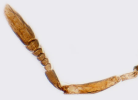
 Antenna: Female (left) and male (right)
Antenna: Female (left) and male (right)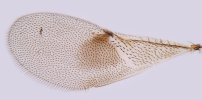
 Forewing: Female (left) and male (right) Forewing: Female (left) and male (right)
ImagesDistributionNative of Mexico. Introduced for classical biological control of the papaya mealybug, Paracoccus marginatus Williams & Granara de Willink in many countries including USA (Florida; Puerto Rico; Hawaii: Palau, etc.), Sri Lanka, etc. Established in Sri Lanka; fortuitously introduced and established in Maldives in South Asia. Similar fortuitous introduction of this parasitoid, apparently with the host, has been reported from Bogor, Indonesia. In Thailand, Cambodia and the Philippines, low numbers of papaya mealybug, some parasitized, have been observed possibly due to the presence of A. papayae or other parasitoids.
Introduced in India in July 2010 and released in the field after quarantine screening in Andhra Pradesh, Karnataka, Kerala, Tamil Nadu, Maharashtra, and Tripura. Apparently accidental introductions of the parasitoid have also been noticed in some parts of Tamil Nadu, Maharashtra, and Karnataka in peninsular India. Established in Karnataka, Maharashtra, and Tamil Nadu and providing substantial control. Biology / HostsA solitary endoparasitoid of papaya mealybug. It parasitizes the early stage (II instar) nymphs of the mealybug.
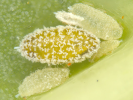
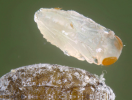 Papaya mealybug mummified by A. papayae (left) and pupa of A. papayae inside (right) References
|



